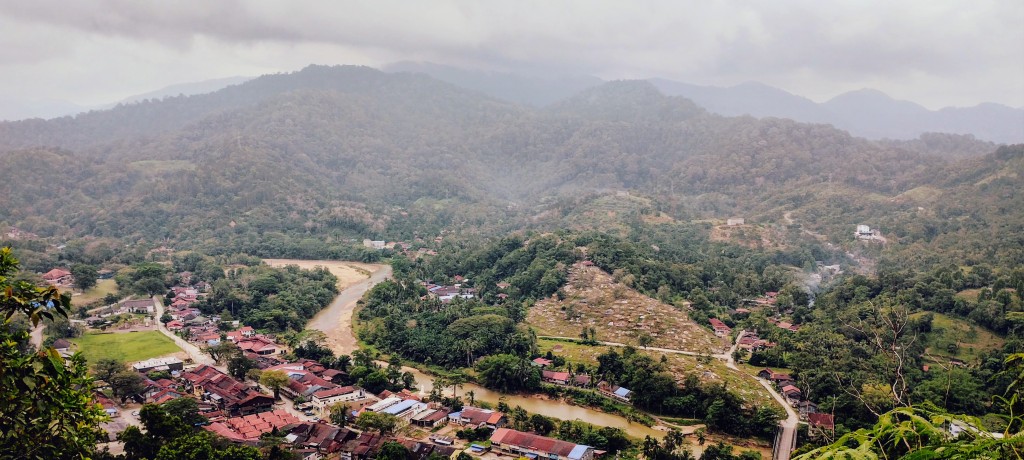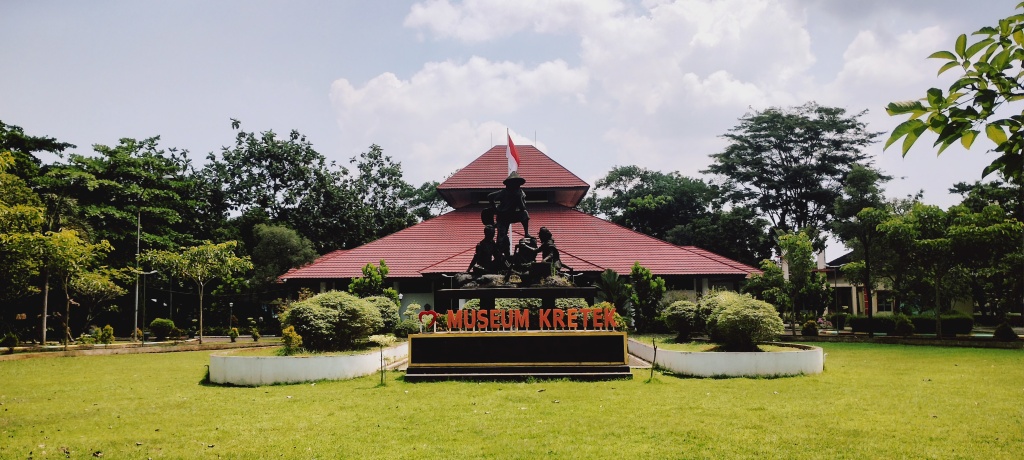The headquarters of the Dutch East Indies Railway Company in Semarang tells a pointed story that extends beyond the development of transport in Central Java. While war raged, far more gruesome acts transpired within the walls of Lawang Sewu, carried out by occupying forces who succeeded solely in scarring the site with their brutality. But as the horrors of conflict gradually subsided, did something of this trauma remain within the site’s confines?
Legend has painted Lawang Sewu as a ghost house. Superficially, this colonial-era building bears all the hallmarks of an imposing old building in the Dutch style, with many high windows resembling nothing so much as ornate doors to some grand cathedral. The view from the building’s high roof may lack the sweeping vistas and intricate landscapes befitting its venerable dignity. However, should the visitor looks beyond the Tuga Madu roundabout below, they may catch a glimpse of the rainbow-hued Kampung Pelangai somewhere along Jl. DR Sutomo.
The reputedly haunted Lawang Sewu is an aged place. It stands to reason that the past, instead of evaporating, soaked into the foundations and spread like a mould, fermenting notions of ghostly spirits and murky atmospheres in its wake and casting an uneasy impression on visitors’ minds.
History will record that Lawang Sewu comprises two main buildings, Cosman Citroen, from the firm of J.F. Klinkhamer and B.J. Quendag, designed the building, and construction began in 1904: the first stage, including a painting house and guard station, finished in 1907 with the other following in 1919. Official recognition came in 1992 with a Cultural Property of Indonesia designation.

So too will the records show a quartet of buildings dominating the site, the larger of which, A and B, offer some insight into the architectural stylings that gave Lawang Sewu its shape. Attention immediately diverts to the L-shaped building: a three-floored structure with two wings flanking its left and right sides, at the intersection of which resides a magnificent marble staircase and stained glass windows designed by Johannes Lourens Schouten. Pottery ornaments atop the balcony complete a scene of refined elegance framed by a pair of domed minaret-like water towers. And below, a tunnel connecting the building to sites in Semarang, including the governor’s mansion and the harbour. A statue of five employees killed in the Indonesian National Revolution stands guard outside.
Building B, meanwhile, lies behind Building A and comprises three floors: two for offices and another housing a ballroom. The windows in B are no less diverting than A, but, as will become apparent, it is the subterranean happenings in that building’s basement that stir the imagination most vividly.
Open Doorways
The building’s name holds a symbolic meaning: in Javanese, ‘lawang’ translates as ‘door’, and ‘sewu’ means ‘a thousand’. It is a symbolic title–in reality, 429 such entrances punctuate the site–that automatically brings to mind notions of passage and deliverance and begs the question of what resides behind these doors and what is trying to get through.
Perhaps such ideas stem from one of Lawang Sewu’s past lives. Scattered around the site lie the husks of trains, carriages and related paraphernalia that indicate a former role as the headquarters of the private railway company Nederlandsch-Indische Spoorweg Maatschappij (NISM), responsible for building the first railway line connecting Semarang with Surakarta and Yogyakarta. The building’s connection with railways throughout Java would remain strong: in its present guise, Lawang Sewu acts as a museum showing its role in shaping Indonesian rail travel.

However, for a time, Lawang Sewu would adopt a more violent form. At one point, it acted as a base in the Indonesian struggle against Dutch colonialists. Then, following the Japanese invasion of Indonesia in 1942, it became the headquarters for the occupiers before reverting to Dutch rule in 1945: the Dutch used the tunnel beneath Building A to sneak into Semarang, and from there, they reclaimed the old building.
Lawang Sewu was not spared bloodshed in this period: a climactic battle between the Railway Youth Forces (AMKA) and the Japanese invaders left scores dead, and events quickly took a turn for the grisly and macabre. Building B’s basement became a dungeon where torture and murder were commonplace, and far more brutal histories transpired.
Read more: Indonesia has infinitely more depth than the visitor may realise. Areas such as these, for instance
And even when Lawang Sewu reverted once more to the national railway company after the war’s end, the residual energy of the atrocities committed within its confines gave rise to all manner of strange encounters and inexplicable presences. Visitors have shared tales of hearing disembodied screams and muffled sobs echoing around the site that tell of enraged, unfocused pain and sorrow.
Aged Shadows
Sure enough, rumours of a more supernatural nature began to stir. Ghost stories grew as Lawang Sewu, neglected and bombarded during the skirmishes and left to fall into degradation, slowly transformed into a shell, a veil hiding the torment entrapped within. Its white walls had become blackened by pollution and the passage of time; before its reclamation by the authorities and transformation into a museum, Lawang Sewu bore the hallmarks of a sickly, diseased patient.
And it was from this husk that gruesome tales emerged. Accounts told of the heinous acts perpetrated in the basement of Building B, where troops of various factions were kept prisoner and suffered horrendous torture. Some fell victim to what became known as the squat prison: a box only 60cm high and measuring 1.5 metres by 1.5 metres that was crammed with up to nine prisoners, who, immersed in water, were left to die in merciless conditions. Such was the psychic scarring from this mode of death that even now, lore states that visitors susceptible to persuasion should not daydream in this basement for fear of falling into a trance. The faint copper-tinged odour of blood plays on the senses and, imagined or not, compounds the hellish conditions.
Not that those spared the squat prison could rest easy: some unfortunates had to contend with the equally malodorous standing prison: a diabolical structure of 60cm diameter and one metre high. Yet more agony abounded: any who survived were beheaded, their bodies thrown into the adjoining river.
The lingering effect of punishment lasts long after the victim has passed beyond the physical. Consider the torture chamber of the third floor, for instance, where prisoners were shackled and starved to death and where anguished screams continue to reverberate, watched over by an indistinct figure whose form remains always concealed.
Memory Remains
These grim acts corrupted the heart of Lawang Sewu and imprinted suffering upon its core; within the dungeon’s murk supposedly exists a human-like shadow with glowing green eyes that will approach, with grim purpose, whoever spies it. Such wraith-like spirits prowl darkened corners and lurk on the periphery. In one apparent ghost passage resides a human figure that masks its true, and infinitely more horrible, form, while a woman’s laughter echoes imperceptibly around the subterranean chamber: a portent, perhaps, of the ghostly female with long hair and vacant eyes rumoured to materialise in the basement’s hallways.
Such communication from ill-defined sources extends to the underground well in front of Building A, from which, at night, mysterious screams emanate. It is no coincidence that the Japanese soldiers executed Dutch prisoners in this well: sources have declared that these sounds have taken on a plaintive tone, as of something blind and lost pleading for release; and indicate that for all of Lawang Sewu’s reintroduction to society, there remain irksome marks on its psyche, forged in blood and doomed never to escape.

Indistinct figures and baffling sightings continue to leave an indelible mark. Consider the apparitions in the main hall: a large black hand covering the window; a white shadow running through the walls; and a beshrouded pocong with a ruined visage gliding close to the ceiling; in Java, pocongs are apparitions that carry the souls of the dead. And along the halls, more terrible portents reveal themselves: a long-haired female ghost, a sighting of whom can result in disaster for the viewer. Given that this figure often appears on camera, it breeds questions of how far these catastrophes would spread if the wider population caught a glimpse of her image.
As is the way of such things, it is at night, when the imagination runs riot and intensifies the smallest kernel of something, that many of Lawang Sewu’s spirits make their appearance. Guards have reported nocturnal sightings of military-looking personnel, dressed in period costume and carrying long-barrelled weapons, patrolling the east and west gates, apparently on duty and unaware that their call of duty had passed a long time ago. Strong winds and the lingering, rancid smell of frankincense and blood accompany these sentries’ lonely, unending watch.
Myths have extended the reach of Lawang Sewu’s phantoms ever further. One tale from the colonial period tells of rapes and other atrocities, culminating in beheadings, committed on Dutch women by Japanese forces. According to one legend, the spirit of a woman who suffered such gruesome acts still roams the river close to Lawang Sewu, smiling serenely and covered in blood. But it doesn’t end there: night watchmen have recalled hearing frightened, terrified screams from the wandering figure, as though embodying the pain of the sadistic punishments meted out to the innocent.








Leave a comment